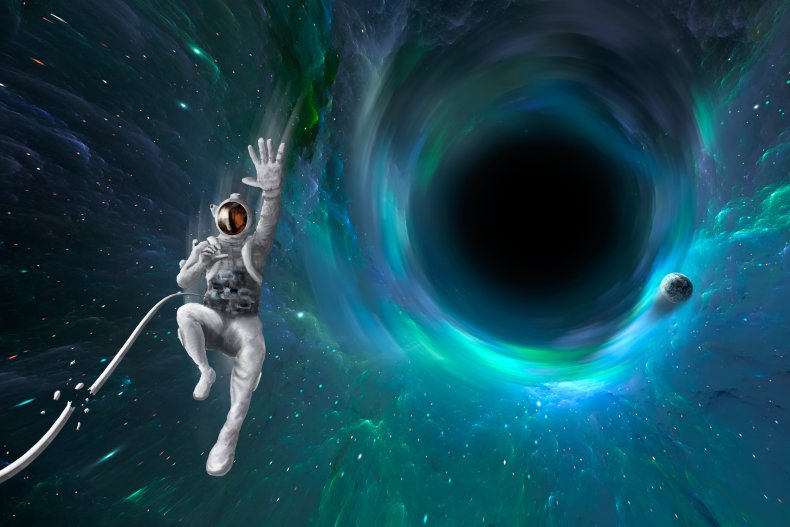Newsweek with Ben Farr: Black Holes
What Would Happen if You Fell Into a Black Hole?
These cosmic bodies are regions of spacetime where gravity is so extreme that nothing, not even light, can escape.
Most of the time, black holes form as the remnants of stars that died in cataclysmic cosmic explosions known as supernovae.
What Is the Structure of a Black Hole?

At the center of a black holes lies the singularity—a one-dimensional point where gravity is predicted to be infinite and the laws of physics as we know them break down.
Surrounding this is a region known as the event horizon—the boundary beyond which nothing can escape due the extreme gravitational pull. The event horizon is named as such because it is impossible to observe any event taking place inside it.
What Would Happen if You Came Too Close to a Black Hole?
So, let’s imagine a hypothetical situation in which humanity has mastered interstellar travel (the closest black holes are thought to be thousands of light-years away) and an astronaut strayed too close to a black hole, either in a spacecraft or while spacewalking. What would happen, and how close is too close?
“The ‘point of no return’ for black holes is the event horizon,” Ben Farr, a physicist and gravitational wave astronomer at the University of Oregon, told Newsweek. “This is the point at which the curvature of space caused by the black hole is so extreme that not even light, the fastest moving particles in the universe, can go anywhere but center of the black hole once it passes it.”
According to Farr, the event horizon for a typical “stellar mass” black hole, say 10 times the mass of our sun, is about 30 kilometers (19 miles) from its center. For a supermassive black hole the size of the one at the center of our galaxy, this figure is far larger—around 12 million kilometers (7.4 million miles).
If you came too close to a black hole, you would be sent into a free fall towards the center, with the gravitational forces increasing as you get closer, creating a pulling force on your body.
But the experience of an astronaut approaching a black hole’s event horizon, very much depends on its size. Perhaps counterintuitively, supermassive black holes may be safer to approach than stellar mass ones—at least in the short term.
“A stellar-mass black hole has such extreme tidal forces outside of its event horizon (an astronaut falling feet first would feel stronger gravity at their feet than their head) that our astronaut would be torn apart well before reaching the event horizon,” Farr said. “Tidal forces are felt by an object when the force of gravity it experiences from some massive object is stronger on one of its sides than the other.”
“Because the event horizon is so much closer to a small black hole than to a big black hole, the effect will be much larger for a small black hole,” Glenn Starkman, a physicist and astronomer at Case Western Reserve University, told Newsweek.
In fact, the tidal forces around a stellar-mass black hole would be strong enough to spaghettify the astronaut and their spacecraft likely from a few hundred kilometers out.
Approaching a supermassive black hole, on the other hand, would be surprisingly peaceful at first, according to Farr, and a free falling astronaut may even be able to reach and cross its event horizon, likely without noticing anything particularly special.
“The astronaut crossing the supermassive black hole should enjoy the trip,” Starkman said. “They probably won’t notice anything unusual, except that the communications from home will become strange—it will seem like they aren’t keeping up to date on your travels.”
In the case of the supermassive black hole, the astronaut would be able to find a stable orbit for their spaceship as close as 24 million kilometers (15 million miles) above its event horizon, which would require no fuel to maintain, according to Farr.
“This is where the gravity around the black hole becomes noticeably different: any closer and the astronaut will have to use the engines of her spaceship to keep from falling into the black hole, and the closer she gets to the event horizon, the greater the thrust she’ll need from her spaceship’s engines escape the black hole, and this becomes infinite as she crosses the event horizon,” Farr said.
What Happens Once You Pass the Event Horizon?
If the astronaut somehow made it to the event horizon of a supermassive black hole, things could get really strange.
“What I have said above assumes that General Relativity is the correct theory at the event horizon. Not everyone agrees that that is the case,” Starkman said. “Some people think that conventional physics breaks down at the event horizon, and all sorts of weird stuff happens to you—including that you possibly never manage to pierce the event horizon.”
But if you did pass the event horizon, what might the astronaut see?
“Once inside the event horizon, there would be substantial warping of images from gravitational lensing (the effect of light traveling on curved paths due to the strong curvature of spacetime), our astronaut could still see events occurring outside the black hole,” Farr said.
However, once past the event horizon, the astronaut’s fate is likely sealed. They would be spaghettified before they reached the singularity, probably within a few minutes of crossing it in the case of a supermassive black hole.